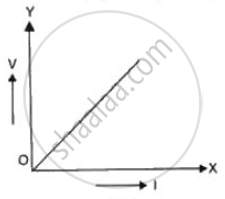Advertisements
Advertisements
Question
State and explain the laws of resistance.
Solution
The following are the main laws of resistance:
(i) Resistance of a conductor is directly proportional to its length, provided temperature and other physical conditions remain unchanged.
It means that R ∝ l i.e., if the length increases, the resistance also increases and if length decreases, its resistance also decreases.
(ii) Resistance of a conductor is inversely proportional to its area of cross section, other conditions remaining the same.
If A is the area of cross section, then:
R α `1/"A"`
or R α `1/(pi"r"^2)`
where r is the radius of the wire
Keeping the length same, if the radius of the wire is doubled then:
R α `1/(2"r")^2` α `1/"4r"^2`
or R α `1/4 . 1/(pi"r"^2)`, or R becomes one fourth.
Similarly if r is made half, then:
R α `1/("r"/2)^2`
α `4/"r"^2 α 4 (1/"r"^2)`, orR becomes 4 times
This shows that R is α `1/"A"`
(iii) R depends on the nature of the material of the conductor. It means, if we take equal lengths of wires of copper, aluminium and iron and all of the same cross-sectional area, their resistance are different from each other since they are of different materials.
APPEARS IN
RELATED QUESTIONS
Find the expression for the resistors connected in series and write the two characteristics of it. (Draw figure).
Judge the equivalent resistance when the following are connected in parallel − (a) 1 Ω and 106Ω, (b) 1 Ω and 103Ω and 106Ω.
Name the material which is the best conductor of electricity.
V = IRTwo resistances X and Y are connected turn by turn : (i) in parallel, and (ii) series. In which case the resultant resistance will be less than either of the individual resistances?R = R1+ R2+ R3
What is (a) highest, and (b)Ω lowest, resistance which can be obtained by combining four resistors having the following resistances?
4 Ω, 8 Ω, 12 Ω, 24 Ω
A graph is plotted taking p.d. along y-axis and electric current along x-axis. Name the physical quantity that represents the slope of this graph (Fig.).

What is the maximum resistance which can be made using five resistors each of `1/5` W?
In an electrical circuit, two resistors of 2 Ω and 4 Ω respectively are connected in series to a 6 V battery. The heat dissipated by the 4 Ω resistor in 5 s will be ______.
